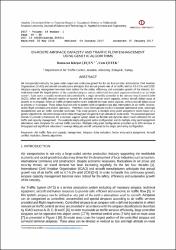| dc.contributor.author | Çeçen, Kürşat Ramazan | |
| dc.contributor.author | Çetek, Cem | |
| dc.date.accessioned | 2019-10-20T19:32:39Z | |
| dc.date.available | 2019-10-20T19:32:39Z | |
| dc.date.issued | 2017 | |
| dc.identifier.issn | 1302-3160 | |
| dc.identifier.uri | http://www.trdizin.gov.tr/publication/paper/detail/TWpRMk9ERXpNdz09 | |
| dc.identifier.uri | https://hdl.handle.net/11421/18592 | |
| dc.description.abstract | Air transportation industry has gone under a rapid and continuous growth for the last four decades. International Civil Aviation Organization (ICAO) and aircraft manufacturers anticipate that annual growth rate of air traffic will be 4.5-5.1% until 2030. Airspace capacity management becomes more critical for the safety, efficiency and sustainable growth of the industry. Enroute areas cover the largest portion of the controlled airspace and are subdivided into small segments referred to as 'en-route sectors'. Each sector is usually monitored and controlled by a single air traffic controller in the relevant Area Control Center (ACC). When air traffic demand reaches or exceeds the available en-route sector capacity, serious aircraft delays occur at airports or in airspace. When air traffic demand reaches to the available en-route sector capacity, serious aircraft delays occur at airports or in airspace. These delays lead not only to system-wide congestions but also interruptions in air traffic services, airline flight schedules and airport operations. Therefore, these interruptions result in increased operational costs, passenger dissatisfaction and air traffic controller workload. This study presents a multiple entry point assignment model based on a genetic algorithm to minimize delays and increase throughput of a generic high-altitude en-route sector. The proposed approach intends to provide a framework for a decision support system based on flexible and dynamic direct route utilization for air traffic and capacity management. The available single entry point sector configuration and its multiple entry point assignment alternatives were compared for various traffic scenarios. Multiple entry point configurations provided up to 10% increase in throughput and significant reductions in average delay per aircraft compared to the single point entry configuration. | en_US |
| dc.description.abstract | Air transportation industry has gone under a rapid and continuous growth for the last four decades. International Civil Aviation Organization (ICAO) and aircraft manufacturers anticipate that annual growth rate of air traffic will be 4.5-5.1% until 2030. Airspace capacity management becomes more critical for the safety, efficiency and sustainable growth of the industry. Enroute areas cover the largest portion of the controlled airspace and are subdivided into small segments referred to as 'en-route sectors'. Each sector is usually monitored and controlled by a single air traffic controller in the relevant Area Control Center (ACC). When air traffic demand reaches or exceeds the available en-route sector capacity, serious aircraft delays occur at airports or in airspace. When air traffic demand reaches to the available en-route sector capacity, serious aircraft delays occur at airports or in airspace. These delays lead not only to system-wide congestions but also interruptions in air traffic services, airline flight schedules and airport operations. Therefore, these interruptions result in increased operational costs, passenger dissatisfaction and air traffic controller workload. This study presents a multiple entry point assignment model based on a genetic algorithm to minimize delays and increase throughput of a generic high-altitude en-route sector. The proposed approach intends to provide a framework for a decision support system based on flexible and dynamic direct route utilization for air traffic and capacity management. The available single entry point sector configuration and its multiple entry point assignment alternatives were compared for various traffic scenarios. Multiple entry point configurations provided up to 10% increase in throughput and significant reductions in average delay per aircraft compared to the single point entry configuration. | en_US |
| dc.language.iso | eng | en_US |
| dc.rights | info:eu-repo/semantics/openAccess | en_US |
| dc.subject | Ortak Disiplinler | en_US |
| dc.title | En-Route Airspace Capacity and Traffic Flow Enhancement Using Genetic Algorithms | en_US |
| dc.type | article | en_US |
| dc.relation.journal | Anadolu Üniversitesi Bilim ve Teknoloji Dergisi :A-Uygulamalı Bilimler ve Mühendislik | en_US |
| dc.contributor.department | Anadolu Üniversitesi, Havacılık ve Uzay Bilimleri Fakültesi, Hava Trafik Kontrol Bölümü | en_US |
| dc.identifier.volume | 18 | en_US |
| dc.identifier.issue | 1 | en_US |
| dc.identifier.startpage | 39 | en_US |
| dc.identifier.endpage | 58 | en_US |
| dc.relation.publicationcategory | Makale - Ulusal Hakemli Dergi - Kurum Öğretim Elemanı | en_US] |


















